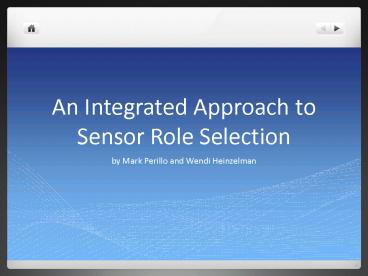An Integrated Approach to Sensor Role Selection PowerPoint PPT Presentation
1 / 36
Title: An Integrated Approach to Sensor Role Selection
1
An Integrated Approach to Sensor Role Selection
- by Mark Perillo and Wendi Heinzelman
2
Outline
- Motivation
- Background
- Modeling
- Solution (DAPR)
- Analysis
- Comparison
- Conclusion
3
1. MOTIVATION (WSN Energy Efficiency)
- Limited energy supply VS long network lifetimes
- Hardware, Operating System, Low-level protocol
design - Balance/reduce energy consumption
- Reduce redundancy but ensure QoS requirement
- dynamic sensor selection, in-network aggregation,
distributed source coding
4
Example for Power reduction
- Operation System eg. TinyOS
- to put microcontroller to sleep
- to put radio to sleep
- Low-level Protocol
- low-level listening on physical layer
- SMAC TMAC on link-layer
- Reduce idle listening, overheads (collision,
overhearing, protocol overheads)
5
BACKGROUND
- Abundant data
- Filter sensors
- Multi-hopping
- Design routing
- Diverse importance
- Assign duties
6
- WHAT HAVE BEEN DONE ?
7
Relevant Work -- Sensor Selection(I)
- Principle desired coverage
- PEAS
- activeness probing/querying
- Gur game paradigm
- state switching according to base station
- Sensing coverage protocol
- sleep/wake time scheduling according to
neighbors with differentiated surveillance - neighbor redundancy, coverage redundancy
- CCP
- coverage and connectivity
8
Relevant Work -- Sensor Selection(II)
- Principle Considering routing
- less sensors some routings short path
desired coverage
9
Relevant Work Routing Protocols(I)
- Principle Shortest path
- Table-driven routing protocol
- destination-sequenced distance vector routing
- clusterhead gateway switch routing
- the wireless routing protocol
- Source-initiated on-demand routing
- ad hoc on-demand distance vector routing
- dynamic source routing
- temporally ordered routing algorithm
- associativity-based routing
- signal stability routing
10
Relevant Work Routing Protocols(II)
- Principle considering energy efficiency
- Power-aware MAC layer routing
- route through nodes with sufficient remaining
power - route through lightly-loaded nodes
- Maximizing the network lifetime
- minimize the energy consumed every packet
11
PROPOSAL Sensor selection Energy conserved
routing PRINCIPLE To use the sensors not as
important as data generators more liberally as
routers
12
Critical NodesThe sensors in the sparsest
regions
13
MODELING Assumptions
- Power consumption largely from traffic
transmitted and received - Portion or entirety of an area A needs to be
monitored by any one or multiple sensors - There may be one or several data sink locations
14
MODELING -- Varianbles
15
MODELING Formalization(I)
Coverage
Number of nodes Nt Ns Nsink
Data flow
16
MODELING Formalization(II)
Energy consumption
Scheduling
Lifetime
17
MODELING Coverage-Aware Routing Cost
Common cost (energy-aware cost)
Total energy in a subset area x
18
MODELING Worst Coverage-Based Cost
Finds out the least-covered subregion
19
E(Xa) 2 E(Xb) 3 E(Xc) 2 E(Xd)
1 Cwc(S1) ½ Cwc(S2) ½ Cwc(S3) 1
20
MODELING Comprehensive Coverage-Based Cost
Weighted sum (in terms of area of subregion) of
1/E(x) It provides a more balanced view of a
nodes importance to the sensing task.
21
E(Xa) 2 E(Xb) 3 E(Xc) 2 E(Xd)
1 Ccc(S1) area(A)/2 area(B)/2 Ccc(S2)
area(A)/2 area(B)/3are(C)/2 Ccc(S3)
area(B)/3 area(C)/2are(D)/1
22
MODELING Combining Cost Functions
Most effective in extending lifetime with 100
percent coverage
Effective in providing long network lifetimes
with graceful degradation
23
SOLUTION DAPR (Distributed Activation with
Predetermined Routers)
The decision made in sensor selection and route
discovery are influenced each other.
Procedure Route Discovery Phase Sensor
Selection Phase Sensor query
24
DAPR Route Discovery Phase(I)
- Assumption
- Nodes have location information of neighbors with
redundant coverage regions - Low power wakeup system
Cost of a link routing cost nodei x energy for
transmission routing cost nodej x energy for
reception
Cost of a route sum of links in the route
25
DAPR Route Discovery Phase(II)
Data Sink
Node
Initiate query
flood query
receive query
Calculate link cost
Update query packet
forward query (delay scheme) proportional to
Clink(Si)
Next Node
26
DAPR Sensor Selection Phase
Initial be inactive to sense and generate data
- Assign activation delay (proportional to the
route cost) - Check received activation beacon
- check if the neighborhood is already covered
- Send activation beacon
- send activation beacon to neighbors if possible
- (Send deactivation beacon)
- send deactivation beacon if in high redundancy
and in the highest cost route - DAPR A Protocol for Wireless Sensor Networks
Utilizing an Application-based Routing Cost
27
DAPR (Contd)
- Awareness of neighbors
- Location
- Redundant coverage
- Given highest priority
- Nodes along highest route
- Reserving opt-out/deactivation beacon
- Sending beacon
- In single hop (Dtransmission_range gtgt
Dsensing_range) - Forwarding (no guarantee)
28
SIMULATIONANALYSIS Simulation result
29
SIMULATIONANALYSIS Experiment Result
30
SIMULATIONANALYSIS Experiment Result for
Sensor Selection
- Configuring activation/backoff delay in Worst
Coverage-Coverage Routing Cost
31
SIMULATIONANALYSIS Experiment Result for
Combing routing cost
- Worst coverage-based energy-aware routing cost
32
COMPARISON to Centralized Approach
- Assuming subject to these conditions
- data flow, energy consumption constraints and
scheduling constraints, we try to maximize the
operation time of the system
33
COMPARISON to Centralized Approach
Uniform scenario worst coverage energy-aware
cost with DAPR gains 14 over the nonintegrated
approach. 56 closer to centralized solution.
34
COMPARISON to Centralized Approach (Condt)
In clustered scenario Worst coverage routing
cost with DAPR improves lifetime by 56. 77
closer to centralized solution, Due to use of the
coverage-aware routing cost.
35
COMPARISON to Centralized Approach (Condt)
In video scenario DAPR with the combined worst
coverage and energy-aware cost makes lifetime
gain 50,Closing gap by 76, Because the
selection of sensors based on the cumulative
route cost.
36
CONCLUSION
- Contribution
- Incorporation of coverage information into the
routing protocol and the priority for sensor
selection - Worst coverage-based cost maintaining 100
coverage for the maximum lifetime - Comprehensive coveraged-based cost giving a
more balanced interpretation of a nodes value to
the sensing task
37
Thank You

